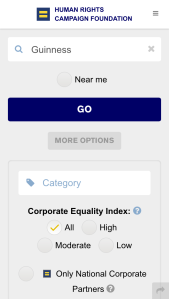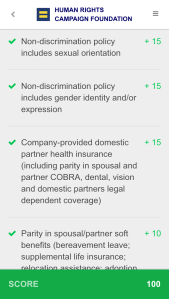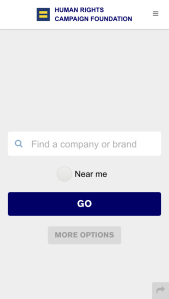
For this assignment I tried finding an app that dealt with the broader issue of my final project—gender stereotypes. I had difficulty finding apps dedicated to this cause, but I did discover the Human Rights Campaign Foundation Buying for Workplace Equality Guide App. This app shows what brands and businesses support workplace equality through activities such as not discriminating based on sexual orientation and gender identity, providing benefits for LGBT employees and their families, and hiring employees from the LGBT community. It does this by rating businesses and their products and categorizing them as green, yellow, or red, with green being the best. You can find out companies’ ratings by searching for them or browsing by category or name. Once you find the brand you are looking for, you click on the score to get a detailed version of what encompasses their rating.

I think the idea behind the app is very compelling can help make an impact in the treatment of the LGBT community in workplaces. However, I do think the app could be more successful in addressing workplace equality based on the Light and Luckin reading. In the reading, the authors discuss how technology-enhanced learning can enable people “to join the debate, voice their views and needs more effectively, and play a greater role in participation” (Light and Luckin 2008, p. 28). Though this app allows users to be a part of the cause by actively searching for ethical places to shop, it does not allow for interaction or direct participation in the app. I think this aspect could potentially help the cause by creating a stronger community. Examples such as FreqOUT! and Museum of the Moment (as seen in the Light and Luckin reading) show the power that social and communicative activities can have on social justice movements. Overall, I think the app is successful in promoting change, but it would be stronger and more effective if it facilitated collaboration and user-generated content.
In terms of privacy, I don’t see much concern as there is no way to identify yourself as the user. If the app did allow users to login and have an identifying name, it could potentially give unwanted people the opportunity to see what the user is doing, as “stalking, watching, creeping, gazing or looking are characteristic of social media use” (Marwick 2012, p. 379). If someone is afraid of broadcasting this information in the event their sexual or gender identity be realized, it could be very discouraging. Currently, the only privacy concern that might be an issue is using Location-Based Services as this could facilitate easier tracking by outside entities. However, it is not a matter of the privacy of the app putting the user at risk, but the services strongly recommended to get full use of the app that could put their privacy at risk.
I also tried turning on different accessibility features and testing them within the app. Unfortunately, they did not seem to be useful for those with disabilities. In the article “Why mobile Web accessibility matters – best practices to make your mobile site accessible,” it is said that those with severe visual impairments rely on screen readers in order to use their mobile devices. Due to this fact, sites and apps should be developed so “that can be decoded and easily navigated by screen-readers” (Soederquist 2012, para. 3). However, the Buying for Workplace Equality App is not easy to understand when read aloud. At first I wasn’t even sure what the phone was reading because it was reading from the menu that was hidden in the corner. It also read “Find a company or brand near me” which sounded like one button.

However, as you can see in the screen shot, it was actually reading the placeholder text in the search box and the “near me” clickable option. I think it would be incredibly difficult for someone to use this app solely off of the sound. In addition to this, the larger text option on my phone did not work on the app.
Overall, I think this is a great social justice app. It gives people a way to see what companies and brands align with their own values, and then shop based off of these findings. I do, however, believe the app would be stronger if it allowed for an already strong community to come together and interact with one another, as is suggested in the Light and Luckin reading. Beyond this, the app could be stronger and used by more people if they were to enhance the accessibility features. As of now, the app appears to be difficult to use for those who have vision impairments. With these minor changes, I believe the app could be a great social justice tool.
Works Cited
Human Rights Campaign. (2012). HRC Foundation Buying for Workplace Equality Guide (Version 5.4) [Mobile application software]. Retrieved from http://itunes.apple.com
Light, Ann and Rosemary Luckin. (2008). “Designing for Social Justice: People, Technology and Learning.” Report for Futurelab.
Marwick, Alice. (2012). “Public Domain: Surveillance in everyday life.” Surveillance & Society. 9(4): 378-393.
Soederquist. (2012). “Why mobile Web accessibility matters- best practices to make your mobile site accessible” from mobiForge.
